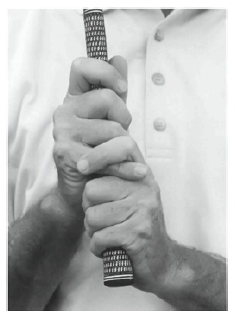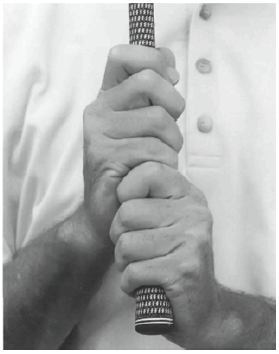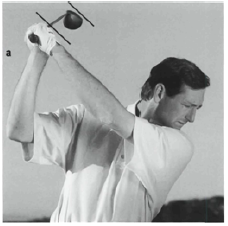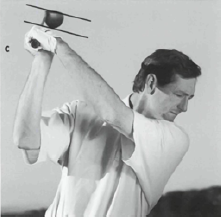Overlap, Interlock, or Ten-Finger? Which is the BEST GRIP?
I don't care. It would be best if you didn't care either. The style of your grip doesn't matter that much. As long as your grip is close to orthodox, it doesn't matter.
A good grip gives you enough flexibility in your wrists to allow them to swing and release freely during the swing. A neutral grip gives you the best chance of keeping the club on the plane. That is, of course, if you have a good swing. A plane swing requires you to have a less than neutral grip. Your grip must match your swing.
It is vital, therefore, that your hands are on the club in a way that allows your wrists to swing easily and freely. And your grip has to match your swing. Think about it. They say that if you don't have a good grip, you can't have a good swing, but as I said, if you don't have a good swing, you don't want a good grip.

Overlapping

Interlocking

Ten-finger … Doesn’t matter. Go with the grip you are most comfortable with
If you are hooking and your grip is strong, or if you are slicing and your grip is weak, it is time to change your grip on the club. Other than that, don't move around.
A Stronger Grip
The grip has generally become stronger over the last 15 years because most teachers are trying to correct the mistakes of good players.
When a good player has the club stuck behind him on the downswing, he will often flip his hands and hit a hook as he hits the ball. The club is different from being stuck behind and coming too much from the inside. You can go too far from the inside and still have the club in front of you. Or you can have the club coming too much from behind you and too much from the inside. These are two different mistakes with entirely different ways of correcting them.

Generally, when you see the club stuck behind, you have to swing the club further left. To get the club to the left-most, players rotate their bodies more through the ball, and everything is now going to the left. Unfortunately, the club is still stuck behind him, and the club face is open because his upper body is in front of the ball. Suddenly, the good players are hitting the ball straight and high.
What was the root cause was an old videotape of Ben Hogan. His club swings to the left at impact. Everyone watches it and sees the club exit to the left, over the ball. But who cares about that? Not me. First thing. What happened to the ball? Where is it going?
In any case, some adjustments had to take place to address this new high right of shooting, and this is where the stronger grips come from. They are compensation for the improper correction of previous errors. Incidentally, if you use a stronger grip to address a "straight-right" shot, you must also accept a lower ball flight. When you hit the ball with a shoulder swing to the left, your right shoulder is right over the ball, deflecting the club. This is why some good players can't get the ball in the air and have difficulty hitting a draw that starts to the right.
Neutral Grip
A neutral grip is at the top of the swing where the left wrist is parallel to the club face.
Not just by looking in the mirror at the address. Check the top of your swing as well. How does the club-face look? If the club face is toed down, your grip may be too weak or your left wrist may be pinched.
If the club face points skyward, your grip may be too strong, or your left wrist is bent.
If you start with a good grip, your club is on the plane, and your left wrist is flush with your left forearm, your club face should be square. If the club-face is open or closed at the top, you have released your grip, and it has moved somewhere in your hand during the back-swing.
63
Hands and Arms
Cock your wrist up and down as if hammering a nail or casting a fishing rod.
The shaft should be perpendicular to the front of your nose - if you do nothing but put your wrist up.
Now, as you swing your arm backward and upwards, rotate your shoulder, turning your left forearm as you do so.
As you get these four things to work together, the club face gradually opens up, in line with the plane and arc of your swing. The shaft will be too steep if you don't rotate your arm. You must turn your arm so that the club is on the plane.
What you should focus on depends on your mistakes.
Ask yourself why your club tends to be too straight off the ball. Is it because of your body? Are your shoulders tilted and changing your posture? Are your arms swinging straight up rather than side to side? Or does your left arm lack rotation?
If the club is too flat, is your body turning too fast and pulling you inwards? This could be because you have no resistance in your lower body. Or is it because your arms and hands are being removed to the inside? Or is it because your hands and associates rotate too much at some point in the backswing?
Question
What should the backswing feel like?
Keep your upper body pivoting on the posture you set up and resist with your lower half. Let your left arm gradually rotate as it swings up and back. Let your wrists hinge up simultaneously, and ensure your arms stay in front of you as you swing the club back to the top of the swing.
When should my wrists cock?
Immediately. But gradually. Nothing says you can't cock them fully immediately, but the danger is getting too narrow a backswing. I don't necessarily change if I see someone who cocks their wrists right away. Seve Ballesteros does it quickly. John Cook does it late. Neither is right; neither is wrong. If I changed either, I'd be teaching personal preference.
As I see it, the wrist cock should be gradual in a perfect takeaway. Your wrists hinge as your shoulders turn. A quarter of the way into your backswing, you should have a quarter of your wrist cock, a quarter of your shoulder turn, a quarter of your arm swing, and a quarter of your forearm rotation. But as long as you are swinging on your plane and your body is pivoting correctly, you can do all four whenever you want during the backswing. Late or early. There are plusses and minuses to both. Early may get a little narrow. Late may make you "flippy" from the top.
When does the club come up?
The club comes up immediately. The arc of the swing is such that the club is on the ground only at address and impact. Everywhere else, the club is either coming up or going down. You bend over from your hips, so your left shoulder turns under slightly, and your right shoulder moves up. What happens immediately, so the club has to come to the ground. For it to stay on the ground, you either have to turn too level, overextend your arms, or drag the club too much to the inside.
Should I take the club back inside or straight back?
The low and straight back doesn’t work because you are standing to the side of the ball. You don’t have to worry about the club moving to the inside. As long as your arms stay “connected” to your body and you turn, your club will move to the interior. The challenge is getting the club to come up with the correct amount as it moves inside. Straight back is off the plane.
Should I take the club back slow?
Not necessarily. It would be best if you took the club back at the natural speed for you as an individual. Concentrate on the correctness rather than the speed of your takeaway. The only time I tell a student to slow down is when he isn’t giving himself time to think about what he is doing.

